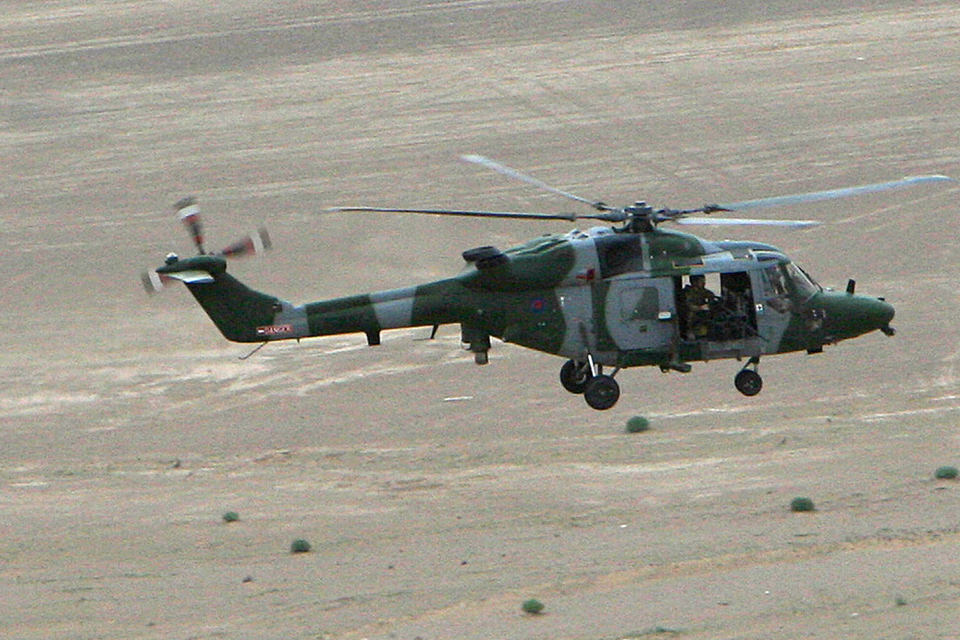Royal Navy Lynx crews leave Helmand for last time
The final tour of duty in Afghanistan of the Commando Helicopter Force fliers of 847 Naval Air Squadron (847 NAS) has ended today, 22 May.
![A Lynx Mk9A helicopter flying over the desert in Helmand province (library image) [Picture: Corporal Barry Lloyd, Crown copyright]](https://assets.publishing.service.gov.uk/media/5a60e8b8ed915d7dfea691ff/s300_HQUKTF-2010-101-165.jpg)
A Lynx Mk9A helicopter flying over the desert in Helmand province
The Lynx helicopter crews, based at Royal Naval Air Station Yeovilton in Somerset, ended their fourth and final deployment to Afghanistan after a 4-month tour of duty working out of Camp Bastion as the ‘eyes in the skies’ for ground forces and RAF Chinook and Merlin helicopters.
847 NAS deployed to Afghanistan in January after a 2-year break from deployments to the country, this time flying Army Air Corps wheeled Lynx Mk9As.

A Lynx Mk9A helicopter coming in to land (library image) [Picture: Corporal Barry Lloyd, Crown copyright]
As well as lacking the distinctive skids of the Lynx aircraft previously flown by the squadron, the Mk9As have more powerful engines – the same as those fitted to the Wildcats which are replacing them – and are armed with a 0.5-inch calibre machine gun.
The missions ranged from escorting RAF helicopters around Helmand to acting as the airborne eyes of international and Afghan troops and security forces when conducting patrols outside operating bases.
To meet those demands, 847 NAS’s engineers and technicians put in 10,500 man-hours of work on the helicopters over 103 shifts. The result was a serviceability rate of over 80% – and over 90% in the final month of the deployment – and 650 hours flown by the squadron.
This detachment has seen weather comparable to the cold temperatures of Norway and, more recently, in the mid-30s Celsius. Personnel also struggled with a tropical storm which led to a flood sweeping through the aircraft hangar, regular sandstorms and some of the highest gusts of winds ever recorded in Helmand during the final days of their deployment.

A Lynx Mk9A helicopter run by Naval Air Squadrons working from Camp Bastion in Helmand province (library image) [Picture: Leading Airman (Photographer) Alex Cave, Crown copyright]
847 NAS’s Commanding Officer, Lieutenant Colonel Nick Venn Royal Marines, said his men and women left Afghanistan having forged ‘an enviable reputation’ with all the units they had worked with since January – and having achieved ‘some real operational successes’:
This tour has been an exceptionally busy one in which the squadron has made a very positive contribution to operations in Helmand – a contribution that is universally recognised out here,” he said.
The fantastic work rate and innovation of the engineering team has ensured that, despite only a small pool of aircraft, we have been able to ‘punch above our weight’, consistently ensuring that we always have aircraft ready to meet operational demands.
In no small part, the work of the squadron has also contributed directly to helping create the secure environment that the Afghans need as they move towards effective self-governance and security; the same secure environment that will allow the UK to leave Afghanistan in due course.
Having handed over duties to the Army Air Corps’ 661 Squadron, 847 NAS was due back at RAF Brize Norton this afternoon, before personnel are bussed down to Yeovilton for reunions with loved ones.
After leave, 847 NAS personnel will begin the conversion process as they get to grips with the Wildcat which is replacing all the Fleet Air Arm and Army Lynx helicopters in the coming years; the squadron is the first front line unit to get its hands on the new helicopter.